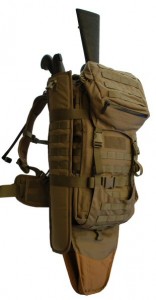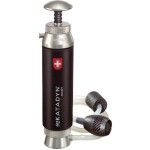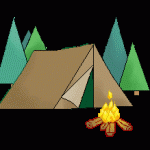

A Bug out bag or B.O.B is a bag that contains all of the necessities you would need to survive after a disaster. The idea is to have your BOB packed and ready to go, so you can grab the bag quickly and get out of dodge should a disaster occur.
Most experts agree that your bug out bag should contain enough supplies to last you at least 72 hours. Since most major disasters can interrupt services and normal way of living for longer than 72 hours, I think it is a good idea to have a bag that will allow you survive for an unspecified amount of time.
Make sure you build your bug out bag to fit your specific needs. Some people may require items that are not listed below. Remember these are just some general recommendations to help you get your bag together. When putting your bag together take into consideration any special needs or items that you or your loved ones might need.
Below I talk about some of the items that you may want to include in your Bug Out Bags, as well as some items that will last when the shtf.
When picking out a pack for your bug out bag make sure you pick out a color that is low profile like black or earth tone colors like olive drab. Because in a true SHFT scenario your going to want to stay as low key as possible. Also consider choosing a pack that can hold a Camelbak reservoir, I went with the Eberlestock Gunslinger II pack because it allows me to carry my AR-15 concealed should I ever have too, along with another rifle like the Ruger 10/22 or a shotgun for hunting game. Learn more about this great pack here.
WHAT SHOULD YOU CARRY IN YOUR BUG OUT BAG?
A Disaster Plan – This should include emergency locations, multiple evacuation routes, maps of the area, including trail maps. An Army survival manual or equivalent. Also have cash & a copy of all your important documents (Gun, Fishing, Hunting, Driver License, SS Card, etc..) keep all of the above in ziplock bags to protect from water.
Water & Purification:
 Water, a liter per day per person, enough to get you by until you can find a clean source. Your going to want a way to filter your water. I use the Katadyn Pocket Water Microfilter
Water, a liter per day per person, enough to get you by until you can find a clean source. Your going to want a way to filter your water. I use the Katadyn Pocket Water Microfilter. You’re also going to want a stainless steel canteen cup (used for boiling water). When choosing a filter it is a good idea to get information on the filter’s micron rating:
Some Contaminants & Their Size In Microns:
Contaminant Size
| Contaminants | Size |
| Giardia lamblia | 8 – 12 Microns |
| Cryptosporidium parvum | 4 – 6 Microns |
| Bacteria (Salmonella – E.coli) | .2 – 4 Microns |
| Viruses | .004 – .1 Microns |
Fire & Cooking:
 A good fire steel
A good fire steeland magnesium stick
for starting fires. You’ll also want waterproof matches
and a good stormproof lighter
. You should always have at least three ways to start a fire.
- Cotton balls with Vasoline on them. Cotton balls make an excellent ignition source to get your fire going quickly and the vasoline will let them burn longer to do so. Keep them in a zip lock bag. You can also use pine tree sap and fat wood when you find it on your way.
- (Optional) Camp stove I recommend the Biolite Camp Stove – This is a great stove you don’t need to carry fuel for it because it burns sticks and pine cones that can be found along the way. This stove is also capable of charging any usb devices like your smartphone, flashlights or batteries.
- Mess kit (GSI Halulite Ketalist
)
- Fishing Kit
– small bobbers, hooks, fishing line and a few lures and some sinkers and a yo yo trap
.
- Edible – poisonous plant guide and a knot tying card. (unless your a pro)
- Snare wire
, Rat Trap – Drill a hole in the rat trap and carry a nail or a screw with it for fastening the trap.
- Three days worth of MRE’s
or freeze dried meals
– energy bars.
Shelter:
 Tarps (2) Recommend the heavy duty all weather space type
Tarps (2) Recommend the heavy duty all weather space type- 0-20 degree sleeping bag or better yet a modular sleep system
. Sleeping bags will fit securely tied on the outside of your pack.
- Ponchos
to protect from rain
- Duct Tape
- Cordage (paracord
etc.)
- Tent
(optional)
Tools:
- A survival knife and a multi-tool (Leatherman Charge). Small sharpening stone.
- A Sling Bow. This is a great tool for hunting
- A folding saw
and shovel. I have the crovel this is a great multi tool
- Hatchet
- Crank style flashlight
. A small flashlight and extra batteries.
- Compass
- Emergency Whistle
- Binoculars
- Signal Mirror
- Gun & Ammo
- Hand & foot warmers
- Glow sticks
Hygiene:
- Toothpaste, toothbrush, wet wipes, soap and a wash cloth, also keep some baking soda you can use it as a deodorant. Don’t forget toilet paper.
- Clothing, Keep your clothes for the climate in your area.
- Socks. One pair thermal type they will keep your feet warm in up to zero degree weather and a good pair of warm gloves.
- A pair of good hiking boots or hiking shoes
- A pair of long pants. I prefer military camo pants they are lighter in weight so if they get wet they dry quicker, they also have ripstop. Make sure you don’t get the cheap ones made in China.
- A pair thermal underwear, pants and shirt.
- 2 shirts
- Bandanas – they have multiple uses in a survival situation
- A hat
- Mosquito net
- Underwear
Medical Kit: I recommend you build your own or buy a basic kit and add to it when you can.
- Allergy medicine
- Prescription medicine
- Band-Aids
- Gauze Pads/Gauze tape
- Alcohol pads
- Benadryl
- Sling
- Finger splints
- Rubber gloves
- Instant cold compress
- Ace bandage
- First aid guide
- Neosporin
- Burn cream
- Tweezers
- Q-tips
- Antibiotics ( Fish Antibiotics can be used in a shtf situation )
- K-103 tabs
- CELOX
First Aid Temporary Traumatic Wound Treatment
- Surgical Skin Stapler
- Sawyer Extractor Pump Kit
Misc.
- Deck of cards
- Food & water for pets
- Sunglasses
- Basic sewing kit